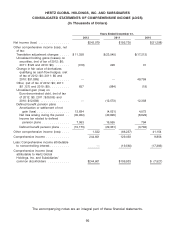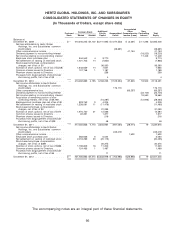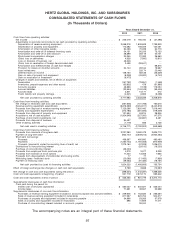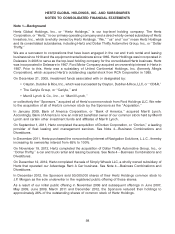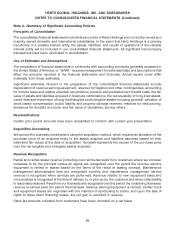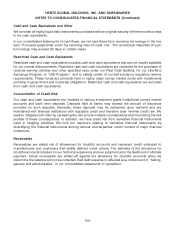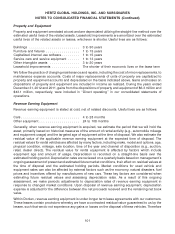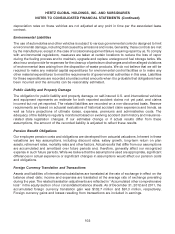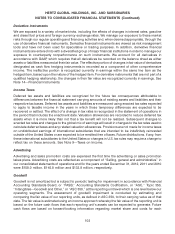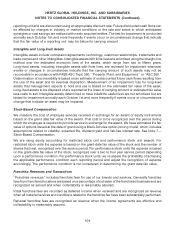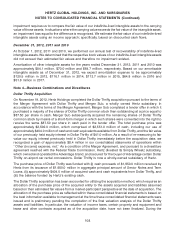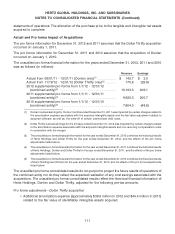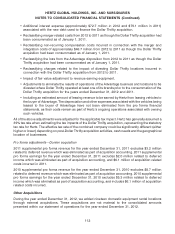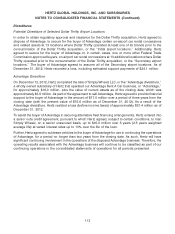Hertz 2012 Annual Report Download - page 128
Download and view the complete annual report
Please find page 128 of the 2012 Hertz annual report below. You can navigate through the pages in the report by either clicking on the pages listed below, or by using the keyword search tool below to find specific information within the annual report.HERTZ GLOBAL HOLDINGS, INC. AND SUBSIDIARIES
NOTES TO CONSOLIDATED FINANCIAL STATEMENTS (Continued)
reporting unit and are discounted using an appropriate discount rate. Future discounted cash flows can
be affected by changes in industry or market conditions or the rate and extent to which anticipated
synergies or cost savings are realized with newly acquired entities. The test for impairment is conducted
annually each October 1st, and more frequently if events occur or circumstances change that indicate
that the fair value of a reporting unit may be below its carrying amount.
Intangible and Long-lived Assets
Intangible assets include concession agreements, technology, customer relationships, trademarks and
trade-names and other intangibles. Intangible assets with finite lives are amortized using the straight-line
method over the estimated economic lives of the assets, which range from two to fifteen years.
Long-lived assets, including intangible assets with finite lives, are reviewed for impairment whenever
events or changes in circumstances indicate that the carrying amount of such assets may not be
recoverable in accordance with FASB ASC Topic 360, ‘‘Property, Plant, and Equipment,’’ or ‘‘ASC 360.’’
Determination of recoverability is based on an estimate of undiscounted future cash flows resulting from
the use of the asset and its eventual disposition. Measurement of an impairment loss for long-lived
assets that management expects to hold and use is based on the estimated fair value of the asset.
Long-lived assets to be disposed of are reported at the lower of carrying amount or estimated fair value
less costs to sell. Intangible assets determined to have indefinite useful lives are not amortized but are
tested for impairment annually each October 1st and more frequently if events occur or circumstances
change that indicate an asset may be impaired.
Stock-Based Compensation
We measure the cost of employee services received in exchange for an award of equity instruments
based on the grant date fair value of the award. That cost is to be recognized over the period during
which the employee is required to provide service in exchange for the award. We have estimated the fair
value of options issued at the date of grant using a Black-Scholes option-pricing model, which includes
assumptions related to volatility, expected life, dividend yield and risk-free interest rate. See Note 7—
Stock-Based Compensation.
We are using equity accounting for restricted stock unit and performance stock unit awards. For
restricted stock units the expense is based on the grant-date fair value of the stock and the number of
shares that vest, recognized over the service period. For performance stock units the expense is based
on the grant-date fair value of the stock, recognized over a two to four year service period depending
upon a performance condition. For performance stock units, we re-assess the probability of achieving
the applicable performance condition each reporting period and adjust the recognition of expense
accordingly. The performance condition is not considered in determining the grant date fair value.
Franchise Revenues and Transactions
‘‘Franchise revenues’’ includes franchise fees for use of our brands and services. Generally franchise
fees from franchised locations are based on a percentage of net sales of the franchised business and are
recognized as earned and when collectability is reasonably assured.
Initial franchise fees are recorded as deferred income when received and are recognized as revenue
when all material services and conditions related to the franchise fee have been substantially performed.
Renewal franchise fees are recognized as revenue when the license agreements are effective and
collectability is reasonably assured.
104



